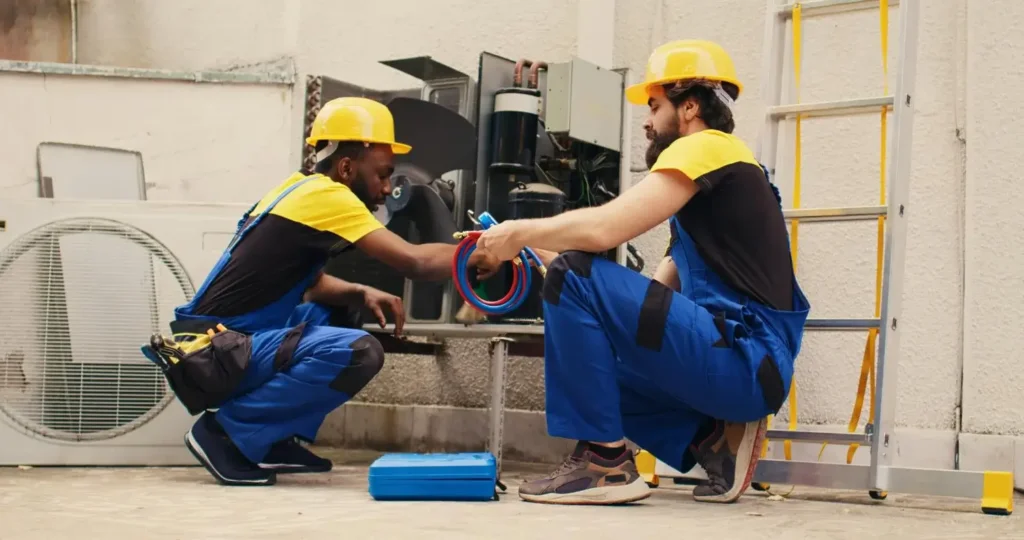
When it comes to maintaining your HVAC system, there are two main approaches: proactive and reactive maintenance. At Everest Mechanical Services, we understand that choosing the right maintenance strategy can make all the difference in keeping your system running efficiently. Today, you’ll be reading about both methods, their benefits, and challenges, so you can make an informed decision that keeps your HVAC system running smoothly and reliably.
What is Proactive Maintenance?
Proactive maintenance, also known as preventive or scheduled maintenance, focuses on regular system check-ups and addressing potential issues before they become major problems. This approach involves routine inspections, cleaning, and servicing of HVAC components to ensure everything is operating efficiently.
Benefits of Proactive Maintenance:
- Prevents Unexpected Breakdowns: Regular inspections and servicing help identify small issues before they become costly repairs, reducing the risk of sudden system failures.
- Extends Equipment Lifespan: By maintaining optimal conditions for your HVAC system, proactive maintenance helps extend the life of key components, delaying the need for replacement.
- Improves Energy Efficiency: Proactive maintenance keeps your system clean and well-calibrated, ensuring it operates at peak efficiency, which can significantly reduce energy consumption and utility bills.
- Better Budget Planning: Since maintenance is scheduled, you can plan and budget for maintenance costs, avoiding the surprise expenses of emergency repairs.
What is Reactive Maintenance?
Reactive maintenance, often referred to as “run-to-failure” maintenance, involves fixing issues as they occur. Rather than scheduling regular check-ups, this approach focuses on addressing problems only when they arise, such as when the system stops working or shows signs of malfunction.
Benefits of Reactive Maintenance:
- Lower Initial Costs: Since there are no planned maintenance visits, reactive maintenance can appear more cost-effective upfront, as you only pay for repairs when issues occur.
- Simplicity: Reactive maintenance is straightforward, requiring minimal planning and scheduling, which can be appealing for businesses that prefer a hands-off approach.
Challenges of Reactive Maintenance:
- Higher Long-Term Costs: Waiting for problems to occur often leads to more significant damage, resulting in higher repair costs and even emergency replacements.
- Increased Downtime: Since issues are addressed after they arise, reactive maintenance can lead to longer periods of downtime while the HVAC system is being repaired, disrupting the comfort and productivity of your building.
- Reduced Equipment Lifespan: Neglecting regular maintenance means that components wear out more quickly, potentially shortening the overall lifespan of your HVAC system.
Proactive vs. Reactive Maintenance: A Side-by-Side Comparison
| Aspect | Proactive Maintenance | Reactive Maintenance |
| Cost | In some cases, higher upfront but more predictable long-term. Quality Maintenance & Inspections = Less service calls & Less operational spend on your HVAC. | In some cases, lower upfront but can result in high repair costs as neglected issues arise, resulting in costly emergency service, rental cooling, and expedited parts/equipment orders. |
| System Lifespan | Extends equipment lifespan | Shortens equipment lifespan |
| Downtime | Minimizes downtime with scheduled check-ups | More downtime due to unexpected failures |
| Energy Efficiency | Improves efficiency and lowers utility bills | May lead to decreased efficiency over time |
| Planning | Requires scheduling and planning | Minimal planning needed |
Which Approach is Best for Your HVAC System?
Choosing between proactive and reactive maintenance depends on your business’s needs, priorities, and budget. Proactive maintenance is ideal for businesses looking to maximize system efficiency, minimize long-term costs, and extend the lifespan of their HVAC equipment. This approach is especially beneficial in commercial settings where comfort and air quality directly impact employee productivity and customer satisfaction.
On the other hand, reactive maintenance might be suitable for businesses with newer HVAC systems or those that want to avoid upfront maintenance expenses. However, this approach carries the risk of higher costs over time due to emergency repairs and equipment replacement.
Conclusion
Choosing the right maintenance strategy depends on your building’s needs, budget, and long-term goals. Proactive maintenance is ideal for those looking to maximize system efficiency and avoid sudden failures, while reactive maintenance may suit newer systems or those seeking to minimize upfront costs. If you’re unsure whether proactive or reactive maintenance is best for your building, or if you have any questions about our services, we’re here to help. Simply fill out the form below for free expert advice.

